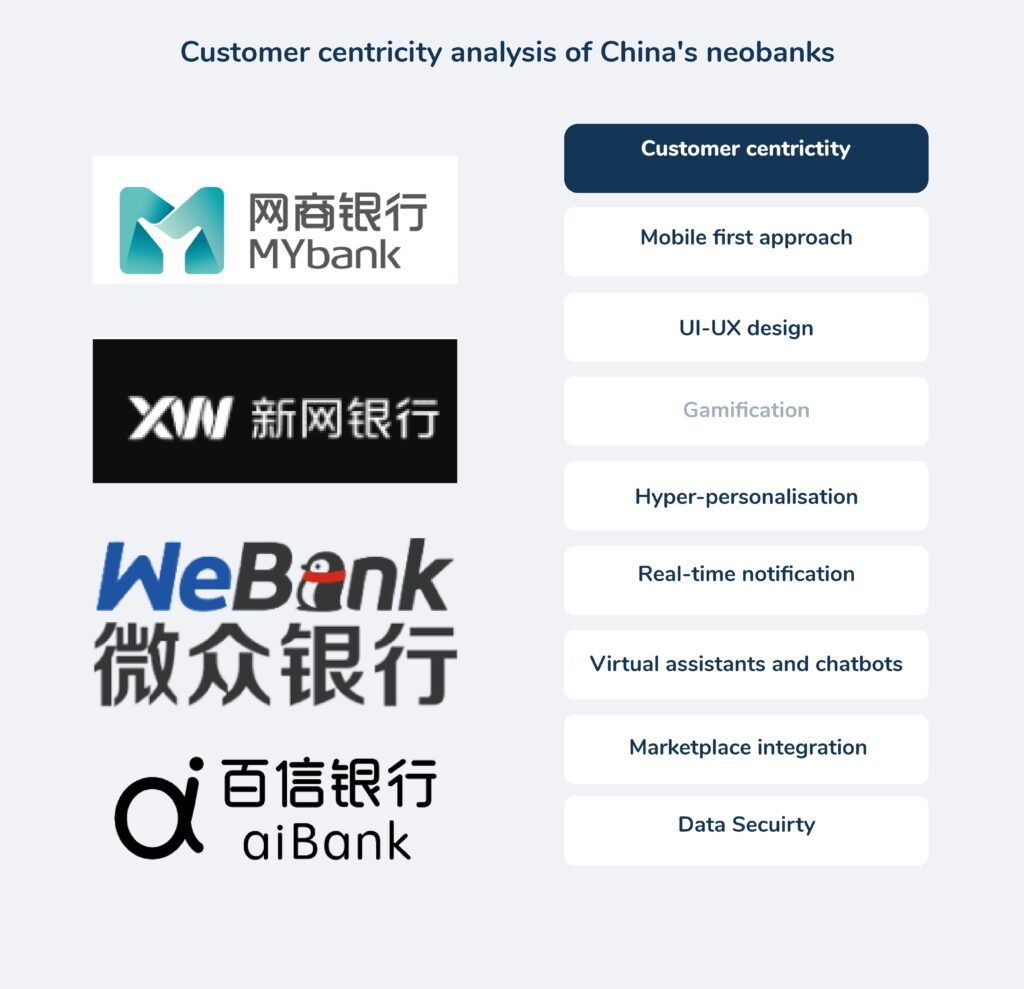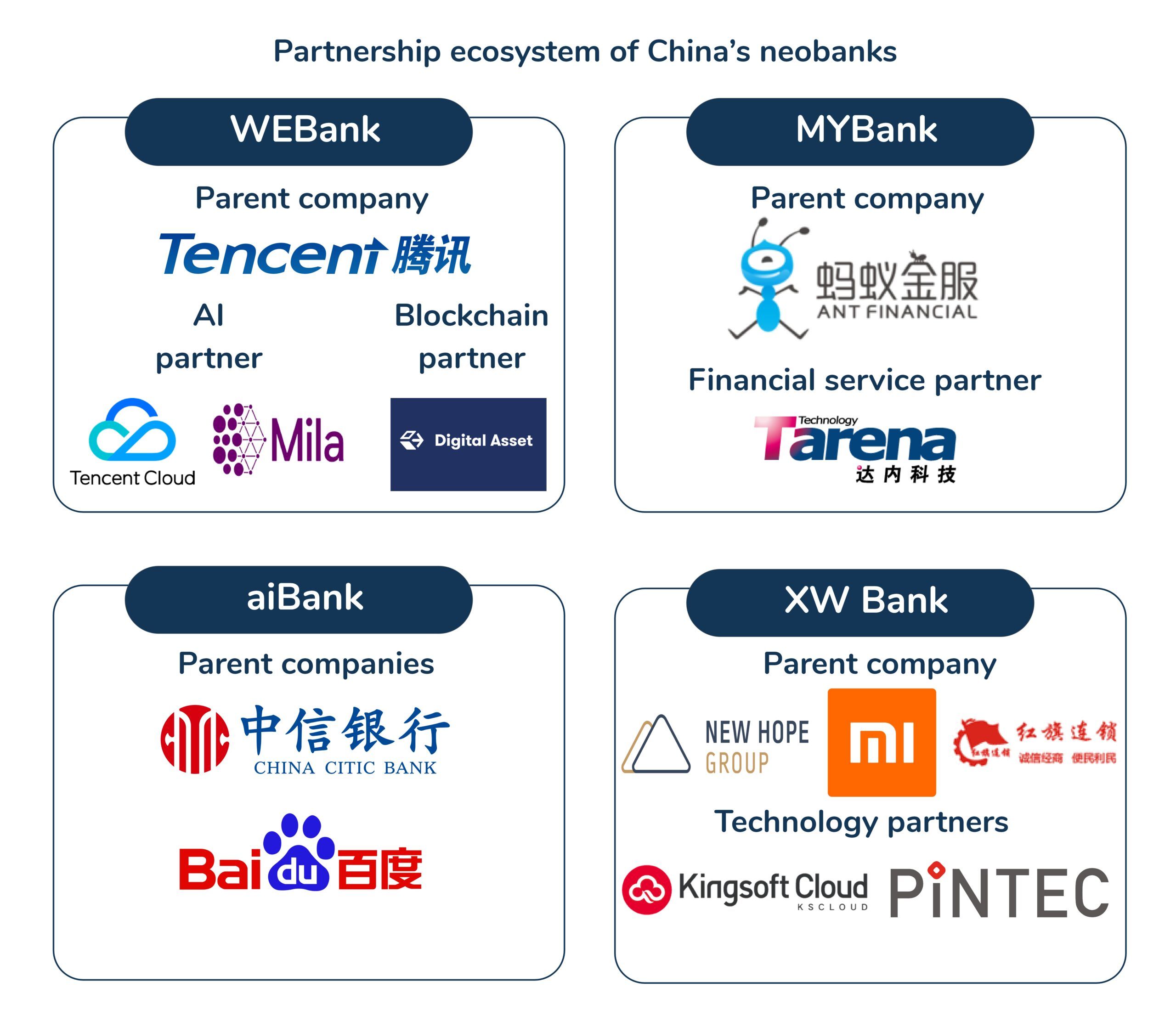The widespread application of advanced technologies in the SME financing space has dramatically improved risk management and lowered costs. – Eric Jing, former chairman of MYbank
Regulatory initiatives
To provide financial services to small businesses and serve the unbanked in China, the Chinese Government is formulating its first set of rules to govern the neo banking ecosystem. This move is expected to minimise the risk in the financial sector and attract new global players in the market.
The new guidelines will foster competition among the state-dominated banks, increase efficiency, and enhance financial inclusion in the country. The rule formation will guide the transformational use of data and disruptive technologies (e.g., AI, blockchain, and Cloud) that are reshaping the banking landscape in China.
While the government is formulating the new rules for neo banking, it has already granted 4 licenses to consortia-led technology companies to form neobanks in China. These standalone neobanks started entering China’s digital banking space in 2014 under the governing Banking Act.
Snapshot of China’s neobanks:
Table 1: Profile of China’s neobanks
| Name | Year | CEO | Annual revenue |
| WeBank | 2014 | David Ku | UD$2210 Mn (FY19) |
| MYBank | 2015 | Simon Hu | US$ 190 Mn (FY19)* |
| aiBank | 2017 | Li Rudong | US$ 350 Mn (FY19) |
| XW Bank | 2016 | Weixing Zhao | Not available |
In addition to the above-listed banks, ING and Bank of Beijing are forming a joint venture to build a digital platform based neobank with the existing license of Bank of Beijing in China. The total investment for the joint venture is CNY 3 billion with ING holding the major stake (51%). The deal is notable both banks for being the first commercial bank on the mainland to have majority foreign ownership. Moreover, the new brand is purely digital.
Table 2: Learning list of China’s neobanks funding capital
| Name | WeBank |
| Total funds raised- Venture series | US $180 Million |
| Name | aiBank |
| Total funds raised- Venture series | Upto $1000 Mn** (May 2019) |
In-depth neobank analysis on the 5-building block framework
Customer centricity:
- All four neobanks in China follow a mobile-first approach, provide real-time notification alert and use UI-UX design to create lucrative and user-friendly tools.
- Only 50% of the banks offer hyper-personalised services such as spending and budget analytics.
- WeBank and MYBank offer virtual assistance round the clock.
Figure 1: China’s neobanks represent 7 of 8 customer centricity parameters

Customer reach:
- 3 out of 4 neobanks in China primarily focus on underserved small-medium enterprises (SMEs).
- WeBank has the largest customer reach with over 200 million customers across the rural and SME segment.
- XWBank caters to over 31 million customers across SME, rural, and millennial segments, thus making it the second-largest neobank in China in terms of customer reach,
- This is followed by MYBank and aiBank with 20 million+ SMEs and 1.6 miilion+ customers respectively.
Figure 2: Customer segment and the total number of customers

Product stack:
- All 4 banks have 50% or more products catering to the customer journey.
- MYbank follows a unique approval mechanism for its 3-1-0 loan.
- Furthermore, Webank offers its rural customers microcredit loans and high credit for its SME customers.
Methodology:
Each neobank product stack is a representation of 4 key parameters across 11 product types
- Unavailable: Does not have a product type in their stack
- Testing: The product is currently in the pilot-testing phase, not live to all customers
- Established: The product is a part of their stack and fully available for customers
- Unique: A unique offering within a product type which is exclusively provided by the neobank
Figure 3: Representation of each neobank’s product stack

Partner ecosystems:
- Neobanks’ partner with technology providers for cloud infrastructure, blockchain, and financial service infrastructure
- All four neo banks are backed by leading tech giants or banks of the country
- WeBank by Tencent
- MYBank by Ant Financial
- AiBank by CITIC Bank and Baidu
- XWBank by Xiami, New Hope Group, and Hongqi Chain
Figure 4: Partnership ecosystem of China’s neobanks

Open banking:
- The banking regulatory authorities have developed a framework governing the open banking ecosystem which will foster competition in the Chinese banking sector. Driven by collaboration and innovation, the consumer adoption rate has accelerated in China’s open banking ecosystem.
- Tencent-backed WEBank is leveraging APIs to build a strong open banking ecosystem. WeBank recently launched the 3O Paradigm of open banking services, namely Open Platform, Open Innovation, and Open Collaboration.
- Ant financial’s Alipay has also launched open banking initiatives by aggregating bank accounts behind the Alipay wallet to data more portable within their ecosystems.
Table 3: API Developers of China’s neobanks
| Name of Bank | Sandbox/Developer |
| WeBank | WeBank Fintech |
| MYBank | Alipay API portal |
Chinese neobanks’ outlook
- The appetite for new and innovative banking solutions by a large tech-savvy population is one of the key drivers of neobanks in China. Research shows that more than two-third1 of banking customers are willing to shift from traditional banking to neo banking, this reflects a bright market for neobanks in China.
- 84%1 of the customers prefer a bank with an outstanding track record and a highly acclaimed reputation. Thus, partnerships by non-banking players with major local banks will enable the banks to tap a larger population.
- Neo banking in recent years has become a battlefield for technology and telecom giants in China, giving rise neo banking unicorns globally. China’s move to formalise digital-only banking rules not only create a possibility for these non-bank players to enter the market but also build an ecosystem of healthy competition, amidst the incumbent banks.
- SMEs and the rural sector in China have been long ignored. With the advent of neobanks that specifically focus on SME and rural banking, there is a surge in the number of banking services availed by SMEs in China.
Endnotes
We have sourced information pertaining to the funding value, round, customer base, revenue, and product information from Crunchbase, Owler, respective company’s annual reports, and their websites.
1GlobalData Research
Akshita Maruthavanan, Research Intern, contributed to this research by assisting in writing, conducting preliminary analysis and conceptualising the topic.